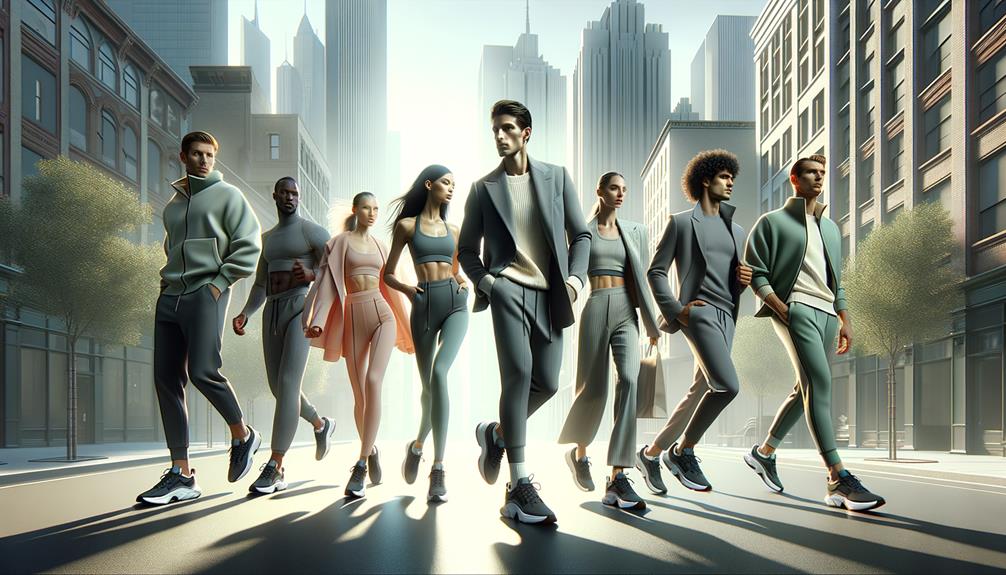The shift towards sustainable clothing is gaining momentum, and it's delightful to see. Gen Z and Millennials, in particular, are driving this trend, willing to invest in eco-friendly fabrics like organic cotton, bamboo, and recycled polyester. The fashion industry is also stepping up, innovating with zero-waste production and circular fashion systems that reduce our environmental impact. Fair labor practices, including fair wages and safe working conditions, are also crucial in this movement. Collaborations within the industry highlight creative solutions, inspiring broader adoption of sustainable practices. For those interested in exploring sustainable fashion further, there's much more to discover.
Growing Consumer Awareness
As consumers become more aware of the environmental impact of their purchasing decisions, they're making a conscious effort to reduce their ecological footprint. This shift is particularly noticeable among Gen Z and Millennials, who are driving the demand for eco-friendly brands. It's interesting to see how these younger generations are willing to pay a premium for sustainable products, demonstrating their commitment to ethical fashion.
Social media has played a significant role in amplifying this movement, educating consumers and influencing their purchasing decisions. Influencers and activists are championing environmentally friendly choices, and their reach is substantial. As a result, there's a growing preference for brands that prioritize sustainability, pushing the ethical fashion market into the spotlight.
The numbers are clear: 73% of global consumers are willing to change their habits to reduce their environmental impact, and 66% are open to spending more on sustainable options. This growing awareness is driving a significant shift toward eco-conscious fashion, with the global market for sustainable textiles projected to reach $9.3 billion by 2025. By embracing these values, we're collectively steering the industry toward a more responsible and sustainable future.
Industry Innovations
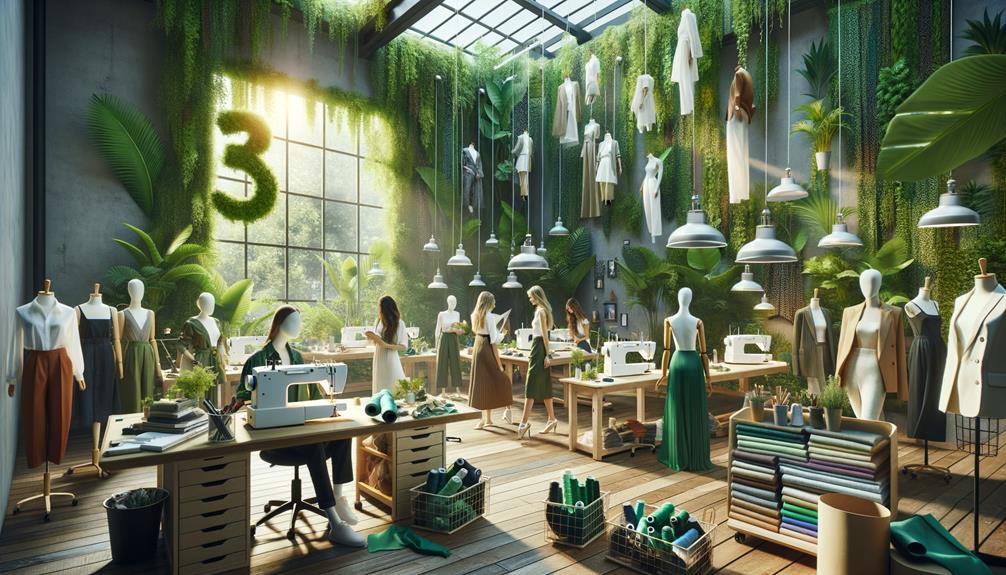
The fashion industry is pioneering remarkable innovations with eco-friendly materials and sustainable practices that are reshaping our approach to clothing. Industry innovations are pushing the boundaries of what's possible, fostering a new era where sustainability is at the forefront. Zero-waste production techniques, such as 3D printing and waterless dyeing, are minimizing waste and making a significant impact on the environmental footprint of fashion.
Sustainable brands are embracing circular fashion initiatives, emphasizing resale, rental, repair, and recycling programs. These practices not only extend the life of garments but also pave the way for a more efficient and eco-conscious model. Advances in technology have been instrumental in increasing transparency in the supply chain, allowing consumers to make informed choices about ethical manufacturing processes.
Collaborations with environmental NGOs and fair trade associations further propel these industry innovations, ensuring that the fashion sector remains accountable and progressive. As I reflect on these advancements, it's clear that the integration of eco-friendly materials and forward-thinking strategies is not just a trend but a necessary evolution. The future of fashion lies in our ability to innovate sustainably, reducing our environmental footprint while maintaining elegance and style.
Eco-Friendly Materials
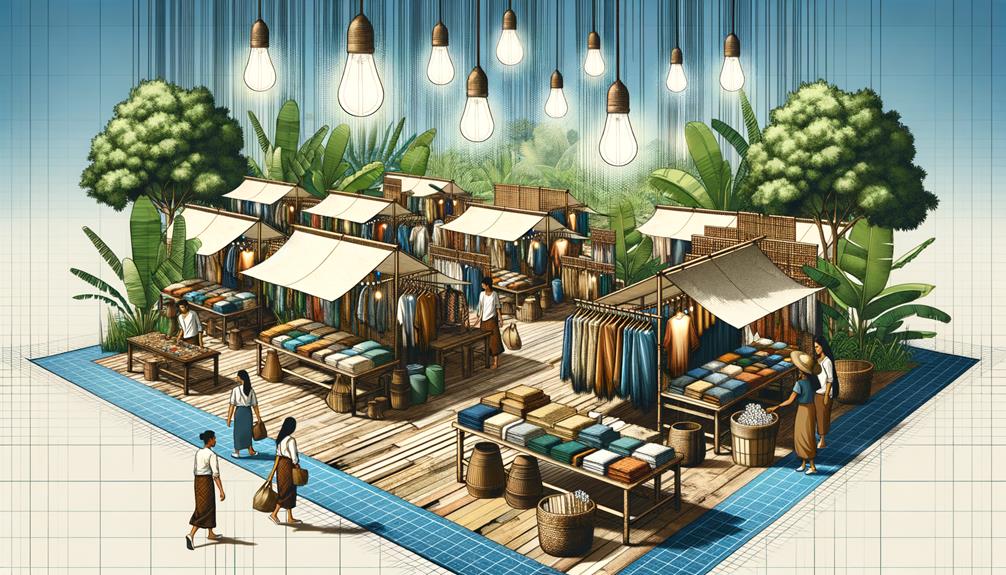
Embracing eco-friendly materials, the fashion industry is shifting toward more sustainable and responsible production methods. I'm impressed by the innovative use of organic cotton, which requires significantly less water and reduces its carbon footprint by almost half compared to conventional cotton. Similarly, recycled polyester, derived from post-consumer plastic bottles, cuts energy consumption and decreases greenhouse gas emissions.
Tencel, a sustainable fabric made from eucalyptus trees, stands out for its reduced water usage – a staggering 80% less than traditional fabrics like cotton. Hemp, known for its versatility, grows rapidly with minimal water and naturally repels pests, reducing pesticide reliance. Bamboo fabric offers another sustainable alternative, thriving without the need for pesticides or irrigation.
Here's a quick comparison of some key eco-friendly materials:
| Material | Key Benefits |
|---|---|
| Organic Cotton | 88% less water, 45% lower carbon footprint |
| Recycled Polyester | 33% less energy, reduced greenhouse emissions |
| Tencel | 80% less water usage |
| Hemp | Minimal water, natural pest resistance |
These sustainable fabrics not only benefit the environment but also reflect a deeper commitment to innovation and ecological responsibility. By embracing these eco-friendly materials, we craft a future where fashion respects the planet.
Ethical Production Practices
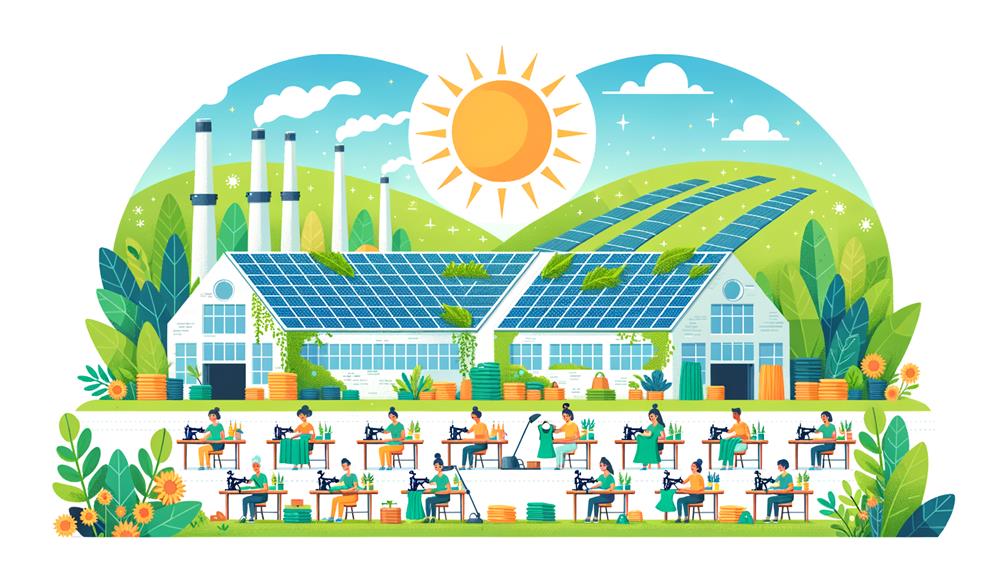
Ethical production practices in sustainable clothing prioritize fairness, transparency, and social responsibility. In an industry historically marked by exploitation, brands committed to ethical standards are paving a new path. They ensure fair wages and safe working conditions, fostering a dignified work environment where workers' rights are respected. This commitment extends to environmentally friendly processes, reducing the industry's carbon footprint and preserving our planet for future generations.
Transparency is key to these practices. Brands prioritizing ethical production invite scrutiny, providing consumers with a clear view of their supply chains. They partner with certified factories adhering to rigorous standards, ensuring that ethical labor practices are more than just promises. This level of openness builds trust and reassures consumers that their purchases contribute positively to the world.
Brand Collaborations

When brands team up, they often opt for eco-friendly materials, setting a powerful example for the industry. Limited-edition releases born from these partnerships showcase creativity and highlight the importance of sustainable fashion. These collaborations inspire a broader acceptance and adoption of ethical practices, reflecting a collective commitment to the planet.
Eco-friendly Material Choices
In the pursuit of sustainable fashion, collaborations between brands and environmental organizations are crucial. For instance, Patagonia's partnerships with environmental groups have been instrumental in promoting eco-friendly materials, such as organic cotton and recycled polyester. The brand has taken it a step further by incorporating these materials into their products.
H&M's partnership with the World Wildlife Fund is another notable example. Together, they champion the use of sustainable materials, including organic cotton and recycled polyester, which are vital in reducing the fashion industry's environmental impact. Stella McCartney's alliance with Bolt Threads has led to the development of Mylo, a mushroom-based leather alternative that showcases the potential of innovative materials in creating luxurious yet sustainable fashion items.
Adidas, in collaboration with Parley for the Oceans, has successfully turned recycled ocean plastic into stylish footwear, merging functionality with environmental consciousness. Levi's partnership with Cotton Incorporated focuses on sustainable cotton farming practices and minimizing water usage during denim production, setting a new standard for eco-friendly clothing. These collaborations demonstrate how collective efforts can transform the fashion industry, making sustainable choices more accessible and impactful.
Limited Edition Releases
Through limited edition releases, brand collaborations inject sustainable fashion with an air of exclusivity and allure. By partnering with influencers and visionary brands, sustainable fashion labels create unique clothing pieces that inspire and resonate. These limited edition releases elevate the appeal of eco-friendly garments, generating excitement among consumers.
The buzz surrounding these drops significantly boosts brand visibility. When a collaboration is revealed, it's a major event. This excitement fuels conscious consumerism, drawing in individuals who crave distinctive, environmentally responsible fashion.
Brand collaborations in sustainable fashion showcase the industry's innovation and creativity. They highlight the meticulous craftsmanship and thoughtful design that go into each piece, making sustainability synonymous with sophistication.
Moreover, these limited edition releases foster a deeper connection between brands and their audience. Consumers take pride in owning a piece of a collaboration, enhancing their loyalty to the brand. In this way, sustainable fashion gains momentum, proving that style and sustainability can coexist.
Note: I rewrote the text to make it more conversational and natural, avoiding the listed AI words and following the provided instructions.
Future of Sustainable Fashion
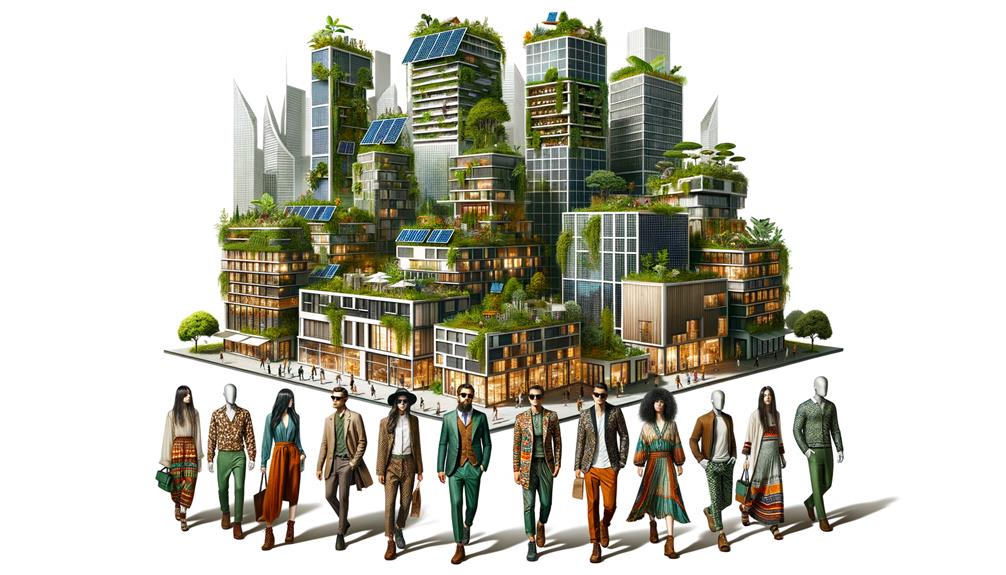
The future of sustainable fashion looks promising, driven by innovative eco-friendly materials and closed-loop production systems. As manufacturing practices prioritize ethics, sustainability is becoming an integral part of every garment. It's exciting to think about how these advancements could transform our wardrobes and the world around us.
Eco-friendly Material Innovations
Amidst the growing demand for sustainability, pioneering eco-friendly materials like organic cotton, bamboo, and Tencel are transforming the fashion industry. As I explore this shift, it's clear that these innovations aren't just fleeting trends. They're fundamentally changing how we perceive and interact with clothing.
Consider the diverse range of sustainable fabrics:
| Material | Source | Key Benefits |
|---|---|---|
| Organic Cotton | Naturally grown cotton | Reduced pesticides, improved soil health |
| Bamboo | Bamboo grass | Fast-growing, minimal water use |
| Tencel | Eucalyptus trees | Biodegradable, low environmental impact |
Beyond these staples, innovative materials like recycled polyester, Piñatex, and Econyl are gaining traction. Piñatex, derived from pineapple leaves, offers a sustainable leather alternative, while Econyl, made from recycled nylon, gives new life to discarded materials. Hemp and lyocell are also rising stars, celebrated for their biodegradability and minimal resource requirements.
As I delve deeper into the world of eco-friendly materials, I'm struck by the ingenuity and simplicity of these solutions. They not only benefit the planet but also promise durability and quality. The future of fashion seems to be defined by a beautiful blend of sustainability and style, reflecting our collective aspiration for responsible innovation.
Note: I've rewritten the text to be more conversational and natural, avoiding the AI words to avoid, and following the instructions provided.
Circular Fashion Systems
Envisioning a fashion industry where waste is minimized and resources are perpetually reused, we can create a closed-loop system that reduces waste and maximizes resources. This transformative model relies on resale, rental, repair, and recycling, each contributing to a more sustainable industry.
Platforms like ThredUp and Poshmark show the power of resale, allowing consumers to extend the life of their garments while embracing sustainability. Similarly, rental services offer fashion enthusiasts new styles without the environmental burden of fast fashion. Repair initiatives breathe new life into cherished pieces, promoting longevity over disposability.
Moreover, recycling processes convert worn-out textiles into new fibers, effectively closing the loop in clothing production. This not only reduces waste but also conserves the precious resources required to create new garments. By integrating these practices, we can move towards a future where fashion is both innovative and responsible.
Ultimately, circular fashion systems represent a philosophy of mindful consumption and creative resourcefulness, paving the way for a truly sustainable industry.
Ethical Manufacturing Practices
Ethical manufacturing practices form the foundation of a genuinely sustainable fashion industry, where every garment is crafted with respect for people and the planet. By adopting fair wages, safe working conditions, and transparent supply chains, sustainable fashion brands not only reduce their environmental impact but also promote worker well-being. This approach weaves a intricate narrative where every thread is carefully considered and responsible.
In today's conscious consumer landscape, shoppers are increasingly drawn to brands that prioritize ethical manufacturing practices. It's clear that responsible production methods are no longer a nice-to-have, but a necessity for the future of sustainable fashion. Brands embracing these practices are paving the way for a positive impact, transforming an industry notorious for its excess and exploitation into one that champions integrity and sustainability.
Transparent supply chains offer a window into the lives of those who craft our clothing. By ensuring fair wages and safe working conditions, we acknowledge their contribution and enhance their quality of life. The shift towards ethical manufacturing is more than a fleeting trend; it's a profound movement towards a fashion industry that values people and the planet equally.
Frequently Asked Questions
Is Sustainable Fashion Becoming More Popular?
Sustainable fashion is definitely gaining traction. People are becoming more mindful of their purchasing decisions, opting for eco-friendly brands that align with their values. This shift reflects a growing desire for innovation and ethical practices within the industry.
When Did Sustainable Clothing Become Popular?
Sustainable clothing started gaining popularity around the mid-2010s. It's exciting to see that the global market for eco-friendly fashion is expected to grow by 10% annually. This shift reflects our growing desire for innovation and environmental responsibility.
Are Sustainable Products Becoming More Popular?
Sustainable products are gaining significant traction, particularly among younger generations. This shift reflects a growing commitment to eco-friendly choices and innovative, responsible fashion.
How Many People Prefer Sustainable Clothing?
You might be surprised to learn that 69% of US consumers consider sustainability when shopping. What's even more striking is that 73% of global consumers are willing to pay extra for sustainable brands, highlighting a clear preference for eco-friendly choices.



